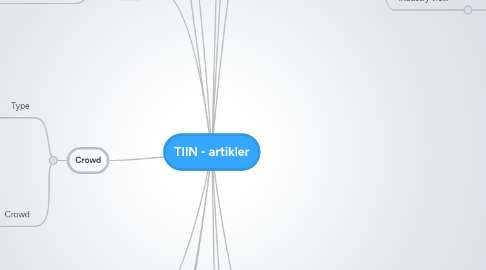
1. Value creation and value capturing
1.1. 8 rules of value creation (IBM Value creation 2.0)
1.1.1. Crab the long tail of demand
1.1.2. Get ready - your customers value digital content
1.1.3. Jump in - virtual words are real business
1.1.4. Embrace your customers
1.1.5. Trust the network - it really does know more than you
1.1.6. Use social networks to create solutions
1.1.7. Embeded flexibility in business models and information systemss
1.1.8. Foster rapid, collaborative innovation in the enterprise
2. Ecosystems
3. Crowd
3.1. Type
3.1.1. Hives
3.1.2. Swarms
3.1.3. Crowds
3.1.4. Mobs
3.2. Crowd
3.2.1. Crowdworking
3.2.2. Crowdfunding
3.2.3. Crowdvoting
3.2.4. Crowdsourcing
4. Context awareness
4.1. Bisgaard, Heise, Steffensen: Categories
4.1.1. Location
4.1.2. Identity
4.1.3. activity
4.1.4. Time
4.1.5. (Environment)
4.2. Features
4.2.1. Proximate Selection
4.2.2. Contextual Commands
4.2.3. Automatix Contextual Reconfiguration
4.2.4. Context-triggered actions
5. Design
5.1. Lee and Benbasat - Interface design for mobile Commerce
5.1.1. 7 C's
5.1.1.1. Context
5.1.1.2. Content
5.1.1.3. Community
5.1.1.4. Communication
5.1.1.5. Collaboration
5.1.1.6. Connection
5.1.1.7. Commerce
5.1.2. 2 M's
5.1.2.1. Mobile Setting
5.1.2.2. Mobile device constraints
6. Big data
6.1. Viral marketing
6.1.1. Kaplan and Haenlein
6.1.1.1. groups of social media marketing campaigns
6.1.1.1.1. Strokes of luck
6.1.1.1.2. Thriumphs
6.1.1.1.3. Nightmares
6.1.1.1.4. Homemade issues
6.1.1.2. Conditions to create an epidemic
6.1.1.2.1. The messenger
6.1.1.2.2. The message
6.1.1.2.3. The environment
7. Privacy
7.1. Barnes: A privacy paradox
8. Strategy
8.1. Dyer and Singh: The relational view
8.1.1. Sources of relational rents:
8.1.1.1. Non-specifc assets investment
8.1.1.2. miniman informetion exchange
8.1.1.3. separable technological and functional systems within each firm that are characterized by low levels of interdependence
8.1.1.4. low transaction costs and minimal investment in governance mechanisms
8.1.2. Determinants of relational rents
8.1.2.1. relation-specific assets
8.1.2.1.1. duration of safeguards
8.1.2.1.2. volume of interfirm transactions
8.1.2.2. Complementary resources and capabilities
8.1.2.2.1. Ability to identify and evaluate potential complementaries
8.1.2.2.2. Role of orgazational complementaries to access benefits of strategy resource complementary
8.1.2.3. knowledge sharing routines
8.1.2.3.1. partner specfic absorptive capacity
8.1.2.3.2. incentives to encourage transparency and discourage free riding
8.1.2.4. Effective governance
8.1.2.4.1. abilty to emply self enforcement rather than third party enforcement governance mechanisms
8.1.2.4.2. Ability to employ informal versus formal self-enforcement governance mechanisms
8.2. Ressource based view
8.3. Industry view
8.3.1. Porters five forces
9. Social media
9.1. Honeycomb of social media: Functionality and Implications
9.1.1. Presence
9.1.1.1. FU: The extent to which users know if others are avaliable
9.1.1.2. IM: Creating and managing the reality intimacy and immediacy of the context
9.1.2. Relationships
9.1.2.1. FU: The extent to which users relate to each other
9.1.2.2. IM: Managing the structural and flow properties in a network of relationships
9.1.3. Reputation
9.1.3.1. FU: The extent to which users know the social standing of others and content
9.1.3.2. IM: Monitoring the strength, passion, sentiment and reach of users brands
9.1.4. Groups
9.1.4.1. FU: The extent to which users are ordered or form communities
9.1.4.2. IM: Memberships rules and protocols
9.1.5. Identity
9.1.5.1. FU: The extent to which users reveal themselves
9.1.5.2. IM: data privacy controls and tools for user self-promotion
9.1.6. Conversations
9.1.6.1. FU: The extent to which users communicate with each other
9.1.6.2. IM: Conversation velocity and the risks of starting and joining
9.1.7. Sharing
9.1.7.1. FU: The extent to which users exchange distribute and recieve content
9.1.7.2. IM: Content management systems and social graph
10. Innovation
10.1. The innovators dilemma
10.2. Service innovation
10.3. Incumbent organization
10.3.1. Hill and Rothaermel
10.3.1.1. Creative Destruction
10.3.1.2. Incumbent in flexibility
10.3.1.2.1. economic explanations
10.3.1.2.2. organization theory explanations (Hannan and Freeman)
10.3.1.2.3. Strategy explanation
10.3.1.3. The attackers advantage
10.3.1.4. Propositions
11. Platform
12. Return on investment
12.1. Nidumolu, Prahalad and Rangaswane: Sustainability
12.1.1. Viewing compliance as opportunity
12.1.2. Making value chains sustianable
12.1.3. Designing sustainable products and services
12.1.4. Developing new business models
12.1.5. Creating next-practice platforms
12.2. Kandybin, Kihn: Raising ROI
12.2.1. Understand your innovation effectiveness curve
12.2.2. Master the entire innovation value chain
12.2.2.1. Ideation
12.2.2.2. Project selection
12.2.2.3. Development
12.2.2.4. Commercialization
12.2.3. Don't do it all yourself
13. Ambidextrous organisations
13.1. O'really and Tushman
13.1.1. Exploitative
13.1.2. Exploratory
